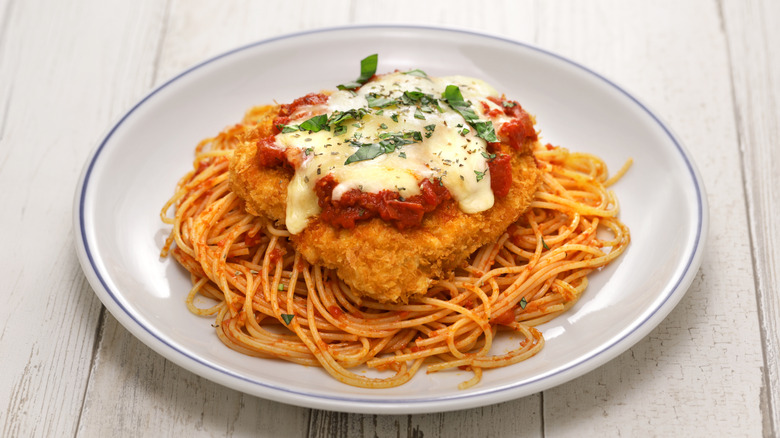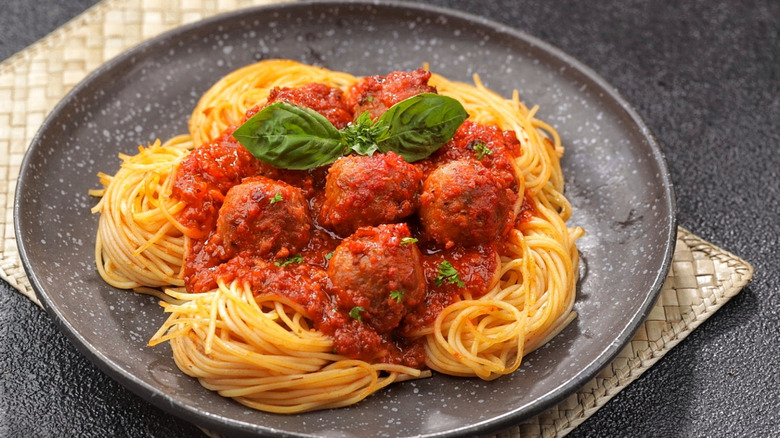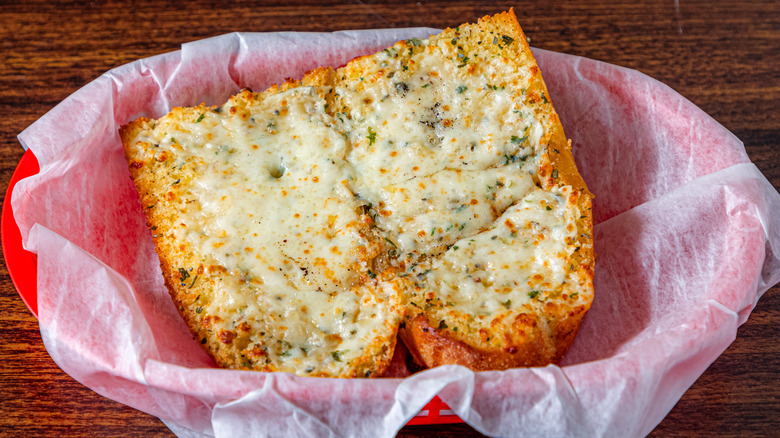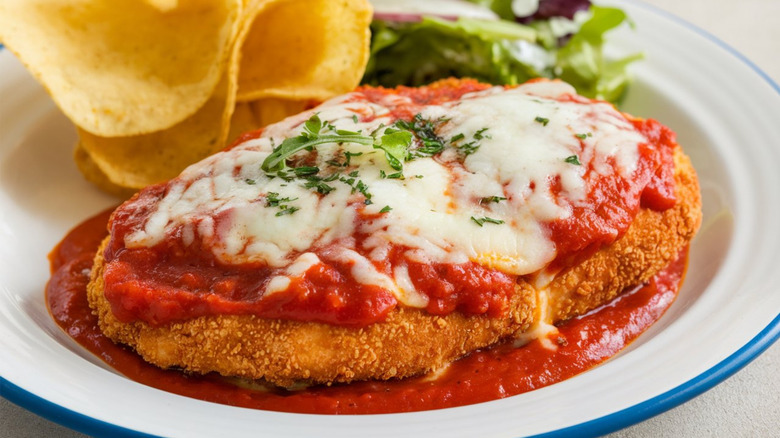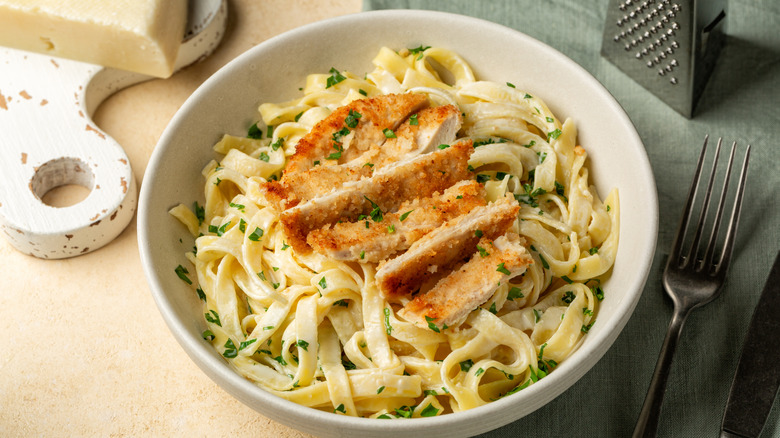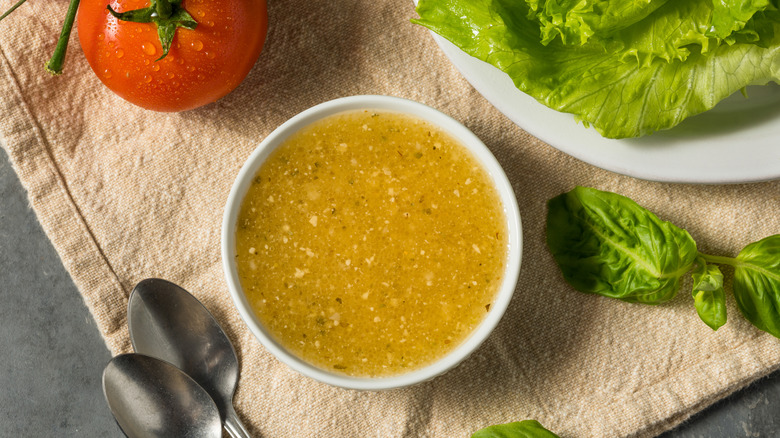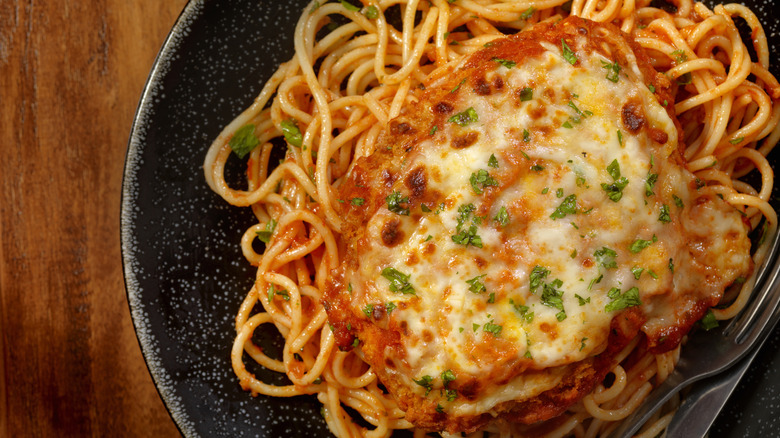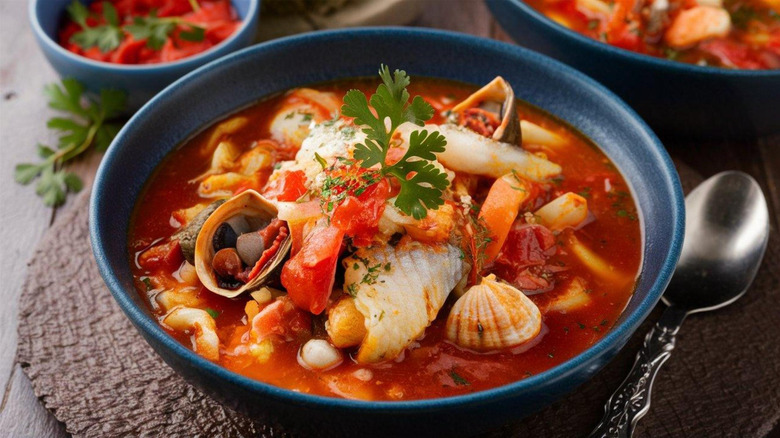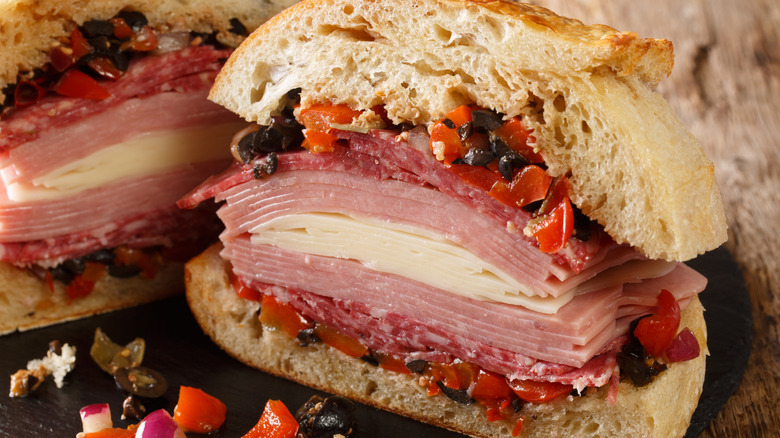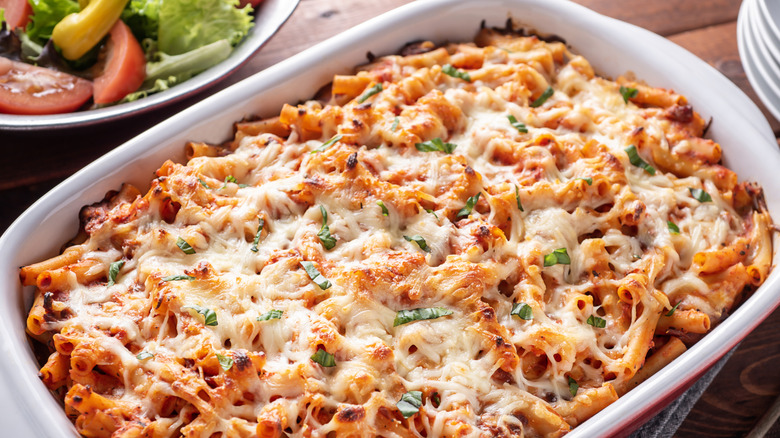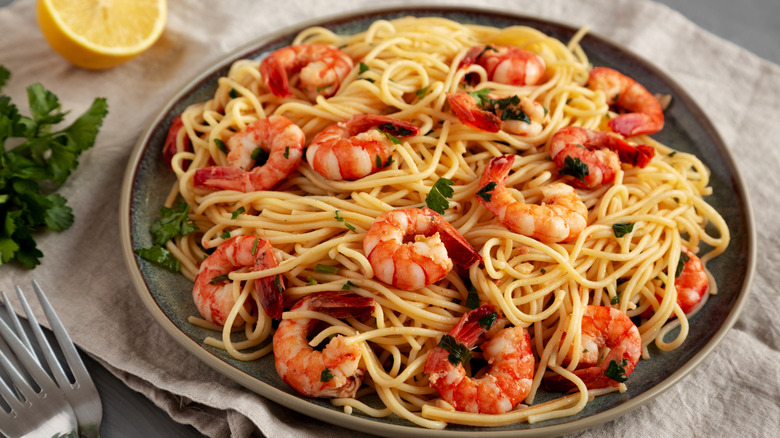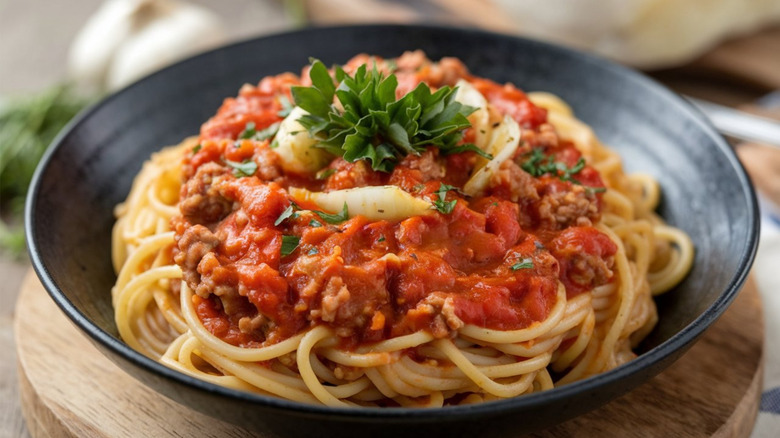13 Foods Americans Think Are Italian (But Totally Aren't)
Italian food is one of the most popular cuisines in the world, and it's easy to see why. Who doesn't love delicious, carb-heavy items that are full of hearty flavor and major comfort? You won't catch us turning down a piping hot slice of pizza or an ooey-gooey pasta dish any time soon. From affogato to zabaglione (and other essentials you should know at an Italian restaurant), there's plenty to love about this cuisine.
However, do you really know Italian food? The stuff popularized by chains like Olive Garden may sound Italian and even look Italian, but is it the real deal? Like many cultures and cuisines, Italian food has been adopted and adapted by American palates as Italian immigrants crossed the ocean and found their home in a new country. Blending Old World with New World was part of the experience, and that included food. Many dishes we know and love may have Italian roots or inspiration, but the ones we're about to discuss, despite appearances and reputation, are not actually Italian.
Spaghetti & meatballs
Spaghetti is Italian, and meatballs are Italian, but the two together do not make an authentic Italian dish. Spaghetti and meatballs is actually an Italian-American creation, invented in New York City by Italian immigrants sometime in the 1800s. (Although we dare say it was rocketed into the public consciousness with the help of Disney's "Lady and the Tramp" –– with its shared noodle-slurping scene –– in 1955.)
According to food historians, meatballs became commonplace among Italian-American immigrants because meat was so readily abundant in their new country, and ground versions were usually cheaper. Traditionally, meatballs were made with a blend of ground beef and ground pork. While thicker sauces in Italian cuisine are usually accompanied by equally hearty noodles, spaghetti, with its long, thin shape, was cheaper and easier to procure than other pastas (although it should still never be broken before cooking). And thus, a classic among Italian-American eateries and homes across North America was born.
Garlic bread
Who doesn't love sopping up the remains of a hearty pasta sauce with a slice of buttery, cheesy garlic bread? Well, as it turns out, Italians don't. Italians are certainly fond of bread, but garlic bread as we know it –– usually a baguette sliced in half, slathered with a garlicky butter and topped with melty mozzarella –– is not on authentic Italian menus, and it's certainly not served alongside pasta.
Like spaghetti and meatballs, garlic bread is an Italian-American invention, likely inspired by the actually-Italian bruschetta. Instead of a baguette, bruschetta is typically made with ciabatta, brushed with good quality olive oil, and then topped with freshly chopped tomatoes seasoned with salt, olive oil, and fresh herbs. Rather than be served alongside the main course, bruschetta is typically served as an appetizer or antipasti at the beginning of a meal. Once again, it was most likely borne out of combining ingredients that were readily available and popular stateside.
Chicken parmigiana
This one might come as a bit of a shock. Does chicken Parmagiana sound Italian? Yes. Does it even include Parmigiano Reggiano, which is Italian? Sure. But the dish itself is not Italian.
Chicken Parmagiana (or Parmesan) is typically served alongside or atop pasta. In Italian cuisine, pasta and protein — like the breaded chicken cutler in chicken Parmagiana — are usually served separately as "primi" and "secondi" courses. Chicken parm smashes these two together, covers it with a whole lot marinara sauce, and smothers it in melted cheese — ironically, more mozzarella than Parmesan. The result is a hearty dish (though you can make it lighter, like Giada de Laurentiis) that was popularized by Italian-Americans in the Northeastern United States and Canada.
Chicken Parmagiana was likely inspired by the Sicilian dish melanzane alla Parmigiana (or eggplant Parmesan),which features rounds of fried eggplant rather than chicken layered beneath and between the sauce and cheese. As with several other non-Italian Italian dishes, meat (in this case, chicken) was more abundant and affordable in the New World, which led to the ingredient swap and created this beloved dish.
Fettuccine Alfredo
This creamy pasta dish is a tricky one, because it does technically have Italian roots. Fettuccine Alfredo was invented by restauranteur Alfredo Di Lielo in 1908 in Rome. The dish was created for his wife, Ines, following the birth of their first son, when he wanted to make something simple and filling to help her regain her strength.
However, unlike the cream sauce-laden version we know today — often accompanied by chicken and a sprinkle of fresh herbs — the original fettuccine Alfredo was much simpler: it was just pasta with butter and Parmesan cheese. Di Lielo's wife Ines loved the dish so much, it was added to their restaurant's menu and began appearing in American cookbooks by 1933. Today's version, of course, is much richer and heavier than the pasta Di Lielo first created, which is why we'd argue that fettuccine Alfredo as we now know it is no longer Italian. (Not to mention, it's often made with the slightly thicker tagliatelle noodle, but perhaps we're nit-picking.)
Italian dressing
Talk about false advertising. That's right — despite having "Italian" right there in the name, Italian dressing is actually not from Italy. Who do we speak to about this?
As it turns out, Italian dressing was created in the postwar United States. The origins are credited to Phillip Sollomi (owner of the Wish-Bone restaurant in Kansas City, Missouri) and Ken Hanna (owner of Ken's Steakhouse in Framingham, Massachusetts) — or, perhaps more accurately, their wives. Around the roughly the same time, both Lena Sollomi and Florence Hanna developed popular dressings, allegedly from recipes passed down by their forbears, which were served in their husbands' respective restaurants. The dressings (which differed slightly from one another) eventually became so popular that each restauranteur went into the food manufacturing business, creating two of the most iconic dressing brands — Wish-Bone and Ken's Foods — still on grocery store shelves today.
As it stands, the Wish-Bone version that was originally served and bottled is closer to what we associate with Italian dressings today, flecked with seasoning and requiring a good shake before use. But both brands offer scores of different variations some of which skew more toward specific ingredients and additions like Parmesan and Asiago cheese. Flavorful? You bet. Italian? Nope.
Veal Parmigiana
Like the aforementioned chicken Parmigiana, veal Parmigiana is also not Italian. Taking inspiration from the eggplant version of the dish, veal Parmigiana came from Italian-American immigrants to the United States and Canada. Since meat was more plentiful and affordable here versus the home country, Italian immigrants created veal parm, a luxurious take on the original Italian dish.
For veal Parmigiana, a veal cutlet is pounded flat, coated in seasoned flour, egg, and breadcrumbs, then fried until crispy. The cutlet is then topped with a hearty marinara sauce and grated mozzarella cheese before being placed in an oven to bake until the cheese is melty. Like the chicken version, veal Parmigiana is also often served alongside spaghetti or a similar pasta with marinara sauce, blending the "primo" and "secondi" courses together. This dish became popular in Italian restaurants in North America, but it is not technically a classically Italian dish.
Cioppino
With its Italian name (pronounced chuh-pee-no), you'd be forgiven for assuming that cioppino came from the country itself. In fact, this fish stew is the creation of Genoan fishermen in 1800s San Francisco. As the story goes, unsuccessful fishermen would go around with a little pot asking his fellow fishers for whatever extra they had before transforming it into a stew with a fragrant, tomato-scented broth. Some have guessed that the name "cioppino" may have come from asking the fishermen to "chip in" a bit with their catches of the day to help their less successful cohort. However, it's more likely derived from ciuppin, a Ligurian seafood soup that uses far less tomato.
Whatever the actual origins, cioppino became popularized in San Francisco in 1852 after Frank Bazzurro began selling it in his restaurant. The dish was a hit, and versions of it have been made ever since, even making its way into the world of Trader Joe's, where a frozen Cioppino Seafood Stew was sold until being discontinued in 2023.
Muffuletta
If you're hankering for a sandwich around mid-day, why not give muffuletta a try? The sandwich with the Italian-sounding name is a stacked one, typically served on a round, seeded Sicilian bread and stuffed with cured meats like ham and salami, provolone cheese, and an olive dressing made from chopped olives, onions, and spices.
However, despite sounding Italian, this sammie isn't. In fact, the muffuletta sandwich comes to us from New Orleans, where it was invented by Italian immigrant Salvatore Lupo in 1906. The sandwich began with Sicilian bread called muffuletto, which was popularized by Sicilian bakeries in the area. It served as a way to combine all the best parts of an antipasto together into one convenient, portable meal. The name of the bread eventually became the name of the sandwich, with a slight alteration. Now, muffulettas served in everything from sub shops to delis, and, while it may have been invented by an Italian, the sandwich itself isn't.
Baked ziti
Baked pasta dishes do exist in Italy, known as "pasta alla forno," with "forno" meaning "oven." Ziti also exists in Italy, with origins in Campania, where it is often served at weddings and other celebrations as a symbol of abundance and good luck. But alas, never the twain shall meet –– at least not in authentic Italian cooking.
Baked ziti is another dish that comes from the mind of Italian immigrants who immigrated to North America in the 19th and 20th centuries. The pasta dish that combines ziti noodles, cheese, sauce, and add-ins like meat or vegetables before baking it in a casserole dish is not a staple in Italian households, but it is pretty common among Italian-Americans. The stick-to-your-ribs comfort meal is hearty and nostalgic, and part of its popularity may be due to the fact that immigrants were looking for a taste of home and a reason to celebrate their new country.
Chicken piccata
The exact origins of chicken piccata are unknown, but most historians point to this dish as being Italian-American rather than strictly Italian. A favorite among Italian-American households (including Carmy Berzatto from "The Bear"), the dish is made with chicken breast dredged in seasoned flour and fried before being added to a butter sauce flavored with lemon, garlic, and capers.
Most believe that chicken piccata is more inspired by Italian cooking techniques rather than an actual Italian dish. "Scalloppine" is a method of cooking that involves coating thin slices of meat in flour and frying them in oil, but some think the flavors of lemon, butter, and salty capers skew more French than Italian.
Served on its own or alongside a thin, light pasta like spaghetti or spaghettini, chicken piccata is a bright, slightly lighter addition to Italian-American cuisine, which can rely more heavily on tomato and cheese than other ingredients.
Chicken Marsala
Another dish that sounds Italian but isn't, chicken Marsala has a surprisingly multicultural history. One of the original fusion foods, if you will. Like chicken piccata, chicken Marsala also featured breaded, pan-fried chicken cutlets. However, instead of a buttery sauce of lemons and capers, chicken Marsala is served with mushrooms in a Marsala wine sauce.
This dish became popular with Italian-American immigrants and gets its name from sweet Marsala wine, which is used in the dish and is also the name of a town in Western Sicily. Marsala wine was regularly consumed by sailors and ship crews who found themselves near the Sicilian shores. A sauce made with Marsala wine dates all the way back to the early 1800s, when it was used by French chefs to serve Sicilian nobility. However, chicken Marsala (or veal Marsala) is not common among actual Italians or in Italy despite its Sicilian roots.
Shrimp scampi
Like fettuccine Alfredo, shrimp scampi is sort of Italian, but has been altered so much from the original incarnation that shrimp scampi as we now know it is a completely different dish.
The original Italian dish was simply called "scampi" and was made with a crustacean known as langoustine, which is "scampo" in Italian. Larger than shrimp, they have a sweet flavor but, since they are considered a delicacy, they're not a type of seafood many on this side of the world are too familiar with. Scampi sees these crustaceans cooked in a buttery, garlicky white wine sauce and is often served tossed with a more delicate pasta.
Shrimp scampi became popular among Italian-American immigrants after World War II, when langoustine was hard to come by and shrimp was more abundant. While the seafood differed, they kept the name, and the popular seafood pasta dish became another example of fusing Italian culture and cuisine with more popular and affordable local ingredients.
Spaghetti Bolognese
Who doesn't love a big bowl of spaghetti with some rich, hearty meat sauce on top? It's so popular in places like the United Kingdom, it's earned its own nickname: "spag bol." But while Bolognese sauced originated in Bologna and can be found on menus and in kitchens throughout Italy, spaghetti Bolognese is not Italian.
The difference lies in what the sauce has become, as well as the pasta it's served with. The traditional Italian version, "ragù alla Bolognese," is also a meat-filled sauce, but it's much less tomato-forward than what might be served in the U.S. or U.K. It contains ingredients like beef, soffritto (carrots, onion, and celery), white wine, and cream or milk. As such, tagliatelle — not spaghetti — is the preferred pasta for ragù alla Bolognese, since the wider noodle allows more of that tasty sauce to cling to it.
But despite significant alterations from its origins, spaghetti Bolognese has remained popular and also reframed what many non-Italians think of when they hear the word "Bolognese." In fact, back in 2019, the mayor of Bologna openly declared that spaghetti Bolognese does not exist to separate his city from the non-traditional dish. It does exist, of course, in the minds and bellies of the millions who love it — but it's decidedly not Italian.
